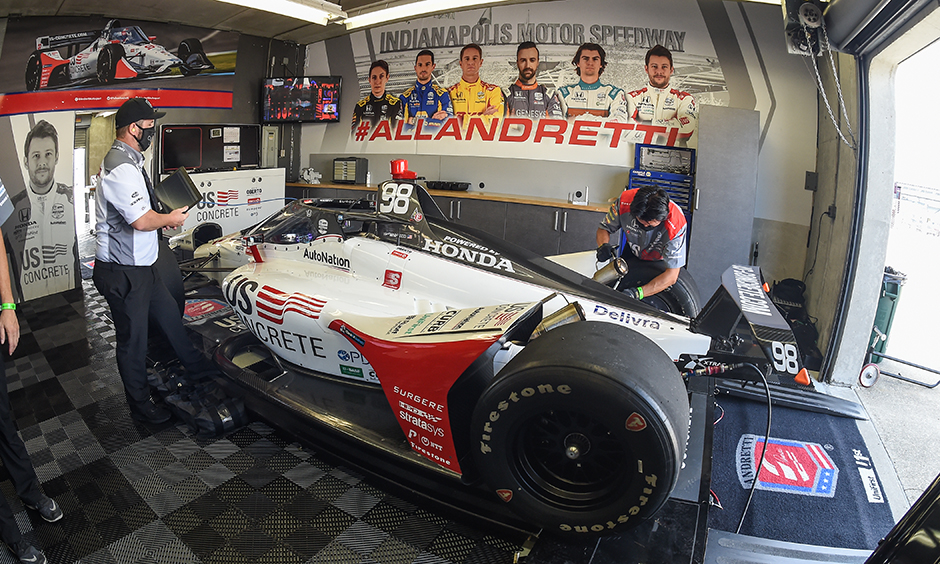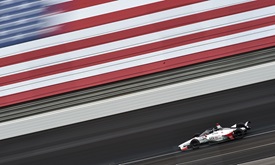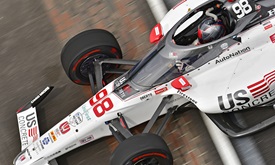Honda Off to Fast Start in Indy 500 Qualifying
AUG 16, 2020
INDIANAPOLIS – Honda teams and drivers earned 11 of the top 12 positions in Crown Royal Armed Forces Qualifying on Saturday at Indianapolis Motor Speedway.
Eight of those Honda-powered competitors will compete in today's Fast Nine Shootout which determines the starting order for the first three rows of the 104th Indianapolis 500 presented by Gainbridge set for 2:30 p.m. Sunday, Aug. 23, with live coverage starting at 1 p.m. on NBC and the Pennzoil INDYCAR Radio Network.
Honda drivers took the top five positions, led by Marco Andretti with a four-lap average of 231.351 mph in the No. 98 U.S. Concrete/Curb Honda. Cars fielded under the umbrella of team owner Michael Andretti swept the top four positions, including Marco Andretti, 2014 “500” winner Ryan Hunter-Reay in the No. 28 DHL Honda (231.330 mph), 2016 “500” winner Alexander Rossi in the No. 27 NAPA AUTO PARTS/AutoNation Honda (231.268 mph) and 2016 “500” pole winner James Hinchcliffe in the No. 29 Genesys Honda (231.195 mph).
RELATED: Andretti Continues Fast Month at Indy
Five-tine NTT INDYCAR SERIES champion Scott Dixon was fifth for Chip Ganassi Racing in the No. 9 PNC Bank Honda at 231.155 mph. Rookie Rinus VeeKay, driver of Ed Carpenter Racing’s No. 21 SONAX Chevrolet, led the Chevrolet contingent in sixth. VeeKay’s four-lap average was 231.114 mph.
Honda drivers filled out the remaining three positions in the Fast Nine Shootout which will be contested Sunday at 1 p.m. (NBC and the Pennzoil INDYCAR Radio Network).
The other Hondas in the Fast Nine Shootout include rookie Alex Palou, driver of the No. 55 Dale Coyne Racing with Team Goh Honda and a pair of Rahal Letterman Lanigan Racing drivers, Graham Rahal in the No. 15 United Rentals Honda and Takuma Sato in the No. 30 Panasonic/PeopleReady Honda. Those three drivers qualified seventh, eighth and ninth, respectively.
Positions 10 to 33 are set for the Aug. 23 race.
Marco Andretti said he wasn’t surprised by Honda’s performance.
“I don't think 'surprised' is the word -- I'm impressed,” he said. “It shows the hard work (Honda has) been doing. It's a lot of credit to them really because horsepower means a lot around this place. That's always the first hurdle of (the event) is having speed.
“From there, it's about making yourself comfortable and everything like that and circumstances.”
Michael Andretti’s organization has entered six cars in this “500.” Four of them will be in the Fast Nine Shootout.
“Honda did a tremendous job,” Michael Andretti said. “We were a bit behind last year, but (Honda) really worked hard over the offseason and gave us the power to be where we are. The team worked very hard, as well, and we have made improvements in our speed.
“It’s been a combined team effort for all of us. Honda really did a great job giving us the power they gave us today.”
Saturday’s success for Honda was the exact opposite of 2019, when Chevrolet appeared to have the edge.
“Last year on Friday before qualifying, we knew we didn’t have a shot,” Michael Andretti said. “Last year, if we could have put one (car) in the top nine we would be good. This year, it’s pretty much flipped.
“Fast Friday last year was all Chevys at the top and Hondas at the bottom. This year, it’s flipped. That’s all a credit to Honda and the work they have done over the winter.”
Honda has an edge in horsepower in qualifications, but what about fuel mileage in the race? This race often comes down to stretching a tank of fuel in a pit window to gain an advantage.
“I think in race trim, the Chevys will be closer to us,” Michael Andretti said. “I think we will be pretty similar in the race next week.”
Ted Klaus is the president of Honda Performance Development and said the higher boost levels for this year’s qualifications have helped give his company an edge. Typically, the boost level being used at Indy in 2020 is what INDYCAR allows for the street and road course races.
“I’m pretty confident we have a combination of power and fuel economy,” Klaus said. “The teams are well-positioned, and we have given them different combinations they can use in the race. There are many options on the table. That makes this race so exciting and unpredictable.”
Klaus said all of the simulation groups were online during the COVID-19 shutdown even though the production facility was shut down. Once everyone returned to work the process continued. Hence, the success.
“Qualifying might be falling in our favor, but the race pace will be more equal,” Klaus said. “I think it will be a race that is won and earned based on racecraft, strategy from the teams and how the driver and teams set up the car to be most consistent throughout long, green flag runs. The tires will fall off.
“Four-lap pace is one thing when it’s just you on the track, but it’s another when you have a pack of skilled competitors around you. I’m always worried of strong competitors on the other side of the aisle.”
The other side of the aisle includes the mighty Chevrolet teams that typically do well in the “500,” including Team Penske, which has won the past two races with Will Power (2018) and Simon Pagenaud (2019).
Team Penske’s drivers will have to drive through the field if they are to win this race. Josef Newgarden will start in Row 5 in the No. 1 Shell V-Power Nitro Chevrolet. Power will start in Row 8 in the No. 12 Verizon 5G Edge Chevrolet. Simon Pagenaud will be in Row 9 in the No. 22 Menards Chevrolet with three-time “500” winner Helio Castroneves in Row 10 in the No. 3 Pennzoil Chevrolet.
“I'd like them to be further back, to be honest,” Rossi said with a laugh. “I think they're really strong cars. Qualifying is a completely separate challenge to the race. In some ways it's harder. In some ways it's easier.
“We've obviously shown our strength. I think they're good race cars, obviously great drivers, a team more than capable of winning the event. Just because we're starting up front doesn't mean we have an easy race day ahead of us by any means. It definitely makes your life a little bit easier.
“For sure it's good to start up front, but we can't rest on our laurels. It’s 500 miles, seven pit stops -- a lot of work.”



















